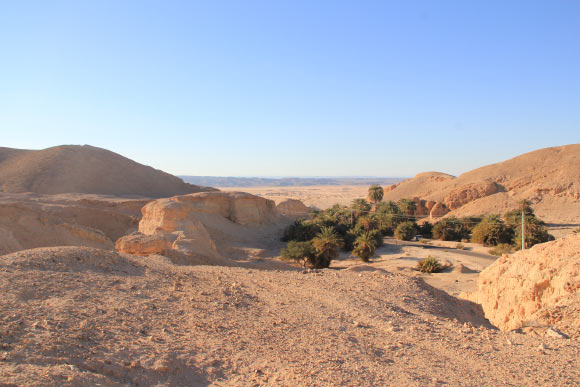Our species, Homo sapiens, dispersed from Africa into Eurasia multiple times in the Middle and Late Pleistocene. According to new research led by Shantou University scientists, the now arid zone of the Eastern Mediterranean was once green savannahs and grasslands that provided an ideal passage for these migrations.

Abbas et al. support the growing consensus for a well-watered Jordan Rift Valley that funneled migrants into western Asia and northern Arabia. Image credit: Center for Climate Physics, Institute for Basic Science.
Homo sapiens evolved in Africa between 300,000 and 200,000 years ago and dispersed out of the continent during multiple episodes, including the last interglacial period (Marine Isotope Stage or MIS 5, between 129,000 and 71,000 years ago).
The geographical routes of dispersal into Eurasia have been long debated, e.g., the northern route from the Sinai Peninsula to the southern Levant then to Arabia, and the southern route via the Bab El Mandeb strait into the margins of southern Arabia.
The southern route, i.e., the Red Sea crossing, is regarded as possible in glacial periods with low sea level.
On the other hand, the dispersal via the northern corridor during 130,000 to 90,000 years ago has been considered the most viable route in MIS 5, given a growing number of archaeological and paleontological discoveries.
These discoveries include hominin fossils and artifacts from the well-known caves of the Mediterranean Levant and the fossil finds, human footprints, and Middle Paleolithic artifacts from the Nefud Desert.
“Our research in the Jordan Rift Valley and Plateau zone clearly shows a humid corridor existed, supporting research in Arabia and the Levant that terrestrial routes were favored by hunter-gatherers wandering across terrestrial ecosystems outside Africa,” said Professor Michael Petraglia, a researcher at Griffith University.
“The presently harsh environment of the Levant and Arabia are the key regions through which members of the genus Homo, including our species Homo sapiens, had to pass through when leaving Africa and moving into Eurasia.”
“The research sheds light on the region around the Jordan Rift Valley as potentially a key successful dispersal route for modern humans during the last interglacial period (MIS 5).”
“The northern corridor crossing the Nile River, into Sinai Peninsula to the Levant region in Arabia and beyond is the only terrestrial route out of Africa.”

A general view of Wadi Gharandal riverine wetland, along the Jordan Rift Valley, showing palm trees concentrated at the center of the wadi near the active spring. Tilted sediments at the northern margin indicate the collapse of the dam, and the wetland sediments are deposited at both sides of the valley. Image credit: Mahmoud Abbas, Shantou University.
In their study, Professor Petraglia and his colleagues conducted fieldwork in the Jordan Rift Valley where they uncovered hand tools, known as flakes, on the edge of wadis — now dry river channels which, tens of thousands of years ago, were full of water.
The researchers used luminescence dating techniques to help establish the age of the sediment the tools were buried in.
This method estimates how long it has been since sediment was last exposed to light.
The results showed the tools were likely to have been used approximately 84,000 years ago and then abandoned on the banks of the wadis and subsequently buried over time.
“It’s long been thought that when the sea level was low, humans used a southern crossing, via the Red Sea from the horn of Africa, to get to southwestern Arabia,” said University of Southampton’s Paul Carling.
“However, our study confirms there was a well-trodden passage to the north, across the only land-route from Africa to Eurasia.”
“Our newly published evidence is a key piece of the puzzle that shows humans migrated using a northern route — using small wetland areas as bases whilst hunting abundant wildlife in the drier grasslands.”
“Although previous studies have looked for large lakes as potential watering holes, in fact small wetlands were very important as staging posts during the migration.”
“The Levant acted as a well-watered corridor for modern humans to disperse out of Africa during the last interglacial, and we have now demonstrated this is the case in the Jordan Rift Valley zone,” said Dr. Mahmoud Abbas, a researcher at Shantou University.
“The paleohydrological evidence from the Jordan desert enhances our understanding of the environmental setting at that time.”
“Rather than dry desert, savannah grasslands would have provided the much-needed resources for humans to survive during their journey out of Africa and into southwest Asia and beyond.”
“Our study demonstrates the intimate relationship between climate change, human survival and migrations,” Professor Petraglia said.
A paper on the findings was published in the journal Science Advances.
_____
Mahmoud Abbas et al. 2023. Human dispersals out of Africa via the Levant. Science Advances 9 (40); doi: 10.1126/sciadv.adi6838







![The image shows NGC 1866 superimposed with a false color image from the MUSE data cube, where the ionized shell of the planetary nebula Ka LMC 1 is seen as a red ring. The grayscale insets illustrate the different size of the ionized shells of singly ionized nitrogen [N II] and doubly ionized oxygen [O III]. The magnified Hubble image near the center of the ring reveals the presence of a pale blue star -- most probably the hot central star of Ka LMC 1. Image credit: AIP / M.M. Roth / NASA / ESA / Hubble.](https://cdn.sci.news/images/2025/11/image_14348-Ka-LMC-1-104x75.jpg)